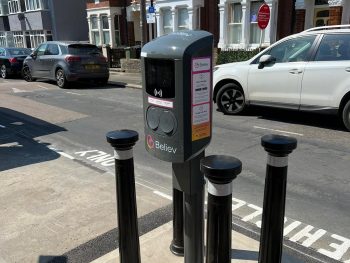Growing North–South divide in England’s EV public charging infrastructure
A disparity in access to budgets and planning between local authorities across England to support charging infrastructure rollout is exacerbating the North–South divide and threatening Britain’s transition to a net zero future.

Whilst 33% of all local authorities surveyed they have no formal EV infrastructure plan in place, the figure rose to 40% for the North
A study by EV charge point operator Believ found that whilst 33% of all local authorities surveyed said they have no formal EV infrastructure plan in place, the figure rose to 40% for the North.
It also revealed an “alarming” difference in budgetary issues, with 70% of respondents in the North saying access to sufficient funding was ‘a significant barrier’, compared with 45% in the South of England (excluding London).
The report also includes data showing charge points are unevenly distributed across the country and disproportionately affecting drivers in the North.
London (34% of the total) and the South East (12%) have the highest proportion of charge points per vehicle, whilst the North East (3%) and the North West (7%) are trailing behind.
As a result, drivers’ access to public charging facilities in the North has fallen by up to 50% in the last year, as the number of charge points per vehicle has failed to keep pace with the rise in demand from the increasing number of EVs on the road.
Many local authorities want government funding to target those areas it defines as deprived and rural, which includes many of the northern ex-mining communities. That call for targeted funding is far louder in the North, with 60% arguing for equity compared with just 36% in the South.
When comparing local authorities that have, and have not, received Local Electric Vehicle Infrastructure (LEVI) funding, only 33% of LEVI-funded authorities believe support should be focused in these areas, in stark contrast to 70% of unfunded authorities.
Believe said these North/South and funded/unfunded disparities suggest local authorities understandably focus on their localities without appreciating the nationwide need – and stressed that this is why the Government must ensure funding is equitably allocated, or risk further increasing the North–South divide.
The challenge for many local authorities is that they feel they cannot justify using local funds to install EV infrastructure while local residents are struggling to cope with the cost-of-living crisis. Some 43% of respondents state installing charge points is too expensive, and almost all of them think residents living in deprived areas cannot afford to buy EVs, so there is no need to build public charging facilities in their area.

Guy Bartlett, CEO of Believ, said there is an urgent need for a more balanced approach to developing Britain’s national EV infrastructure
Yet half (51%) of UK drivers purchase second-hand cars, and the price of second-hand EVs is now comparable with petrol and diesel. Drivers who want to buy an EV because of the lower running costs may well be put off by the lack of accessible charging.
Believ’s research suggests that the South East has succeeded in driving consumers to switch to EVs by first building a robust charging infrastructure, rather than waiting for demand from residents. The region had the highest number of charge points outside London and subsequently has the highest number of used EV sales, totalling 28,107 in 2023.
Guy Bartlett, CEO of Believ, said the survey shows there is an urgent need for a more balanced approach to developing Britain’s national EV infrastructure.
“We must address disparities in the pace and scale of the rollout across the UK. It is crucial to ensure an equitable transition to sustainable transportation and mitigate the risk of a growing North-South divide.
“Local authorities,” he continued, “need support for the enormous task of fulfilling the government’s net zero ambition. They should also be encouraged to use the private sector to help them fund and build EV infrastructure so that no community is left behind.”
To access Believ’s report on local authority charging rollout, please click here.













Leave a comment